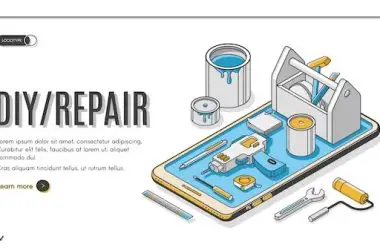An aspect ratio refers to the proportional relationship between the width and height of an image or screen. It is expressed mathematically as a ratio of width to height, written as width:height. For example, an aspect ratio of 16:9 means the width is 16 units and the height is 9 units.
Some common aspect ratios used in devices and displays include:
- 4:3 – Used in older TVs and computer monitors
- 16:9 – The most common widescreen aspect ratio used today in TVs, computer monitors, laptop screens
- 16:10 – A popular widescreen aspect ratio found in laptops and monitors
- 21:9 – An ultrawide aspect ratio found in high-end monitors and TVs
19.5:9 is a newer aspect ratio that has emerged in recent years. It sits between the conventional 16:9 and 21:9 ultrawide ratios, providing a balance of immersive viewing and practicality.
History of 19.5:9 Aspect Ratio
The 19.5:9 aspect ratio was first introduced in 2017 with the launch of the LG G6 smartphone. LG touted the device’s 5.7-inch QHD+ display with its taller, narrower screen dimension as immersive for multi-tasking and viewing multi-media content. . As reported by Display Aspect Ratio, by extending the height of the display while keeping it narrow allowed the LG G6 to retain the ergonomic benefits of one-handed use for a 5.7” screen.
Following the LG G6, other smartphone makers like Sony, Xiaomi and Motorola also adopted displays with the 19.5:9 aspect ratio. The slightly elongated display allowed phones to shrink their bezels and expand screen real estate without making devices too wide. It became an appealing ratio for phone makers looking to stand out with all-screen front designs. According to Quora, the 19.5:9 ratio allowed for a balanced approach providing more vertical space while maintaining usability. While wider ratios like 21:9 provided even more height, they made devices too narrow for easy handling.
Display Size and Dimensions
The 19.5:9 aspect ratio results in a taller, narrower display compared to the more common 18:9 ratio. For a 6.5″ diagonal screen size, a 19.5:9 display would measure approximately 2.96″ x 6.38″, while an 18:9 display of the same diagonal size would be 3.07″ x 6.26″.
So in practical terms, a 19.5:9 display of a given diagonal size will be slightly narrower and taller than an 18:9 screen. This gives more vertical space that some people find beneficial for web browsing and reading long text content.
In a phone with a 6.5″ diagonal 19.5:9 display, the resolution would need to be approximately 1080 x 2340 pixels to maintain the proper aspect ratio. Compare this to approximately 1080 x 2280 for 18:9.
The 19.5:9 ratio is also taller and narrower compared to even older 16:9 displays. So it provides more screen real estate vertically while remaining easy to hold in one hand horizontally due to the narrower width.
Advantages of 19.5:9
The 19.5:9 aspect ratio offers some key advantages compared to more traditional 16:9 or 18:9 ratios. According to sources, the main benefits are:
More vertical space for content – The extra height provided by 19.5:9 allows more content to be displayed on the screen at one time, reducing the need for scrolling. This is especially useful for reading articles, viewing documents, or browsing social media feeds.
Enhanced gameplay and video watching – The taller aspect ratio provides a more cinematic and immersive experience for entertainment content like movies, shows, and games. It allows for bigger picture and minimizes black bars.
One-handed usability – The narrower width compared to the height makes it easier to grip the phone and reach all areas of the screen with just one hand. This improves ergonomics and convenience.
Overall, the 19.5:9 ratio strikes a good balance between one-handed use and high information density. The extra vertical space is highly beneficial for common smartphone tasks like reading, typing, and browsing.
Disadvantages of 19.5:9
While the 19.5:9 aspect ratio offers some benefits, it also comes with some drawbacks.
One disadvantage is letterboxing of older media content. Since most video content before 2017 was filmed in 16:9 format, watching this older content on a 19.5:9 screen results in black bars on the sides. This wastes screen space and detracts from the viewing experience.
Another disadvantage is that the taller display can make it difficult to reach the top of the screen with one hand, which can be inconvenient for one-handed use (Source).
Additionally, the 19.5:9 aspect ratio does not yet have widespread adoption. Most content and apps are still designed for 16:9 or 16:10 screens, so they may not fully utilize the extra vertical space. Aspect ratios like 18:9 and 21:9 are also competing for popularity. Until one ultra-wide format clearly dominates, fragmentation will remain an issue.
Use Cases and Applications
The 19.5:9 aspect ratio is commonly used in various devices today, especially:
Smartphones
Many smartphone brands have adopted 19.5:9 displays in their flagship models, including Apple, Samsung, Huawei, and OnePlus. The extra vertical space is useful for multitasking, viewing photos, browsing websites, and social media.[1] The slimmer aspect ratio also enables manufacturers to increase screen sizes without making phones too wide to hold.
Gaming Phones
Gaming phones like the ROG Phone 5 utilize 19.5:9 displays to provide an immersive experience for gameplay while also fitting comfortably in landscape orientation. The cinematic aspect ratio is well-suited to racing games, RPGs, and more.[2]
Tablets
Tablets such as the Huawei MatePad Pro adopt 19.5:9 displays to showcase more content while remaining easy to grip. The extra vertical space is ideal for e-reading, web browsing, and apps.[3]
Foldable/Dual Screen Devices
Foldable phones like the Samsung Galaxy Z Fold leverage the 19.5:9 aspect ratio to provide enhanced multitasking and app experiences across the expanded display.[4] Dual screen devices can also showcase two apps in their native 19.5:9 dimensions without letterboxing or distortion.
Comparison to Other Aspect Ratios
The 19.5:9 aspect ratio has some key differences compared to other common aspect ratios like 16:9, 18:9, and 4:3.
19.5:9 vs. 18:9
The 18:9 aspect ratio was popularized by Samsung and LG in 2017. It offers a taller, narrower display compared to 16:9.1 19.5:9 builds on 18:9 by being even taller. The extra height is useful for multitasking by showing more content on the screen. However, widescreen videos may appear smaller or have larger black bars on a 19.5:9 display.
19.5:9 vs. 16:9
The 16:9 aspect ratio has been the standard for widescreen TVs and computer monitors for many years. It provides a good balance between width and height for video content. However, 16:9 screens are not as optimized for vertical viewing and multitasking compared to taller ratios like 19.5:9.2
19.5:9 vs. 4:3
The 4:3 aspect ratio was common on older TVs and computer monitors. It has a square-like shape that is even wider than 16:9. 4:3 provides a lot of horizontal space but less vertical space. This makes it poor for multitasking. Widescreen videos also appear very small on a 4:3 display or have large black bars on the top and bottom.
Future Outlook
The 19.5:9 aspect ratio is likely to gain wider adoption as more smartphone manufacturers move to taller, narrower displays. This elongated aspect ratio is better suited for foldable and flexible display designs that unfold to reveal larger screen areas like the Samsung Galaxy Fold and Huawei Mate X.
With foldable devices, the extra height in 19.5:9 displays allows for a more natural tablet-sized experience when unfolded, while remaining compact when folded. This makes the aspect ratio well-suited for innovative form factors.
The added vertical space also enables more immersive uses of the display like split-screen multitasking, multi-window modes, and enjoying cinematic content. As content creators and app developers optimize for 19.5:9, the user experience will feel more engaging.
Overall, the 19.5:9 aspect ratio unlocks new possibilities in smartphone design and usage, and should see wider adoption as foldable displays become more mainstream. Its elongated shape caters nicely to emerging trends while providing a more adaptable canvas for content and apps.
Final Thoughts on the 19.5:9 Aspect Ratio
After reviewing the history, dimensions, pros and cons, and use cases of the 19.5:9 aspect ratio, it’s clear this new format offers some compelling benefits. The extra vertical space is ideal for multitasking and viewing more content at once. The cinematic style provides an immersive entertainment experience. And the flexibility to adjust between 19.5:9, 19:9, and other ratios makes it versatile across uses.
While wider than traditional 16:9 screens, 19.5:9 displays don’t feel uncomfortably long horizontally thanks to their balanced dimensions. The additional space enhances productivity and multmedia enjoyment. As device manufacturers continue optimizing features for this aspect ratio, and content creators embrace the more vertical field of view, expect 19.5:9 to gain traction across smartphones, tablets, laptops, monitors, and televisions.
With major brands like Samsung, LG, Sony, and Xiaomi on board, 19.5:9 stands poised for massive growth in the next few years. Its advantages for work and play make 19.5:9 a truly innovative advancement in display technology with an exciting future ahead.
Sources
The information in this article is based on the following sources:
- Android Authority: What is 19.5:9 aspect ratio?
- Samsung: What is Infinity Display?
- TechRadar: Best smartphone 2022
- Tom’s Guide: Best and Worst Smartphone Screen Sizes
Additional research and analysis by [author name].

